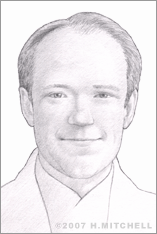Timothy Swager
Technology developed by organic chemist Timothy M. Swager has the potential to save countless lives through its ability to detect trace amounts of explosives as effectively as, if not better than, a trained canine.
Born July 1, 1961, in the small town of Sheridan, Montana, Swager worked on a ranch as a teenager before he entered Montana State University. There he completed a BS in chemistry in 1983, followed by his pursuit of graduate and doctoral studies at the California Institute of Technology(CalTech). He completed his PhD in chemistry there in 1988 while working under the direction of Robert H. Grubbs, 2005 recipient of the Nobel Prize in chemistry.
Swager relocated to the east coast upon completion of his doctoral degree to accept a postdoctoral position at the Massachusetts Institute of Technology (MIT). He remained there until 1990 when he joined the chemistry faculty at the University of Pennsylvania (UPenn). He held the post of assistant professor from 1990-1996, when he was named professor. Later that year he returned to MIT as a professor of chemistry.
He became specifically interested in the study of conducting polymers, or plastics that conduct electricity much like metals or semiconductors do, while a student at CalTech. At UPenn in 1995, Swager first demonstrated amplification by molecular wires, or electronic polymers. This would lead to his development of amplifying fluorescent polymers, or AFPs, which form the backbone of the technology behind Swager’s groundbreaking “Fido” sensors.
Named in reverence to dogs, which until this point have been the most effective tools available for sniffing out bombs and explosives, Fido sensors are the most sensitive explosives detection devices ever produced and allow small, portable, handhelds to detect trace amount of chemical vapors. The sensors are approximately 10,000 times more sensitive than are those presently used by most airport security systems, able to detect traces of explosives at extremely low chemical concentrations – as low as just a few parts per trillion.
Swager’s research was funded, in part, by a U.S. military research grant; he licensed the technology to a company called Nomadics in 2001, now a division of ICx Technologies. U.S. soldiers are already using his sensors in areas such as Iraq to scan people and vehicles for hidden explosives and bomb-making materials. Firms such as Foster-Miller Inc. and iRobot are also producing robots equipped with these sensing devices to scope out dangerous locales and hard-to-reach places. In 2005, Fido was named winner of the U.S. Army Greatest Invention Award.
Other possible uses for Swager’s sensor technology include helping to detect landmines, protecting passengers on transportation systems, and building security.
Holder of 29 patents or patents pending, Swager has been honored with numerous awards for his work, including the 2005 Christopher Columbus Foundation Homeland Security Award, the 2000 Cope Scholar Award, and Fellowship in the Academy of Arts and Sciences. He was also the 2007 winner of the $500,000 Lemelson-MIT Prize. He has published more than 200 articles and sits on the board of several technology firms, as well as on the National Research Council's Committee on Operational Science and Technology Options for Defeating Improvised Explosive Devices.
In 2005, Swager took on the role of chairman of MIT’s chemistry department and was named John D. MacArthur Professor of Chemistry. He continues to hold his post as a John D. MacArthur Professor of Chemistry as of 2015.


